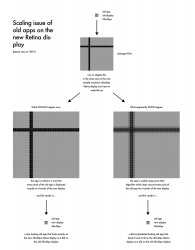Hi,
I just got back from the Apple Store, where I had a look at the Retina MBP.
I was specifically interested in how older apps that are not yet "retinafied" would look.
And to my surprise they look REALLY bad, totally pixelated.
Now, I do understand that they would not look as crisp as apps that are retinafied, but they should look no worse than apps on the "legacy MBP".
The resolution on the Retina MBP is 2880x1800 and apparently when you do not enable scaling everything is displayed with the same "display real estate" as it was on the old MBP (which has a resolution of 1440x900). That means an app on the new Retina MBP should be displayed at the exakt same size as the same app on the old MBP, only it would be displayed crisper of course.
That also means: When you have an old app, this app could just put one of its pixels into 4 of the new Retina pixels and therefore use an effective resolution of 1440x900 on the new Retina MBP. That means the App should look EXACTLY the same as it did on the old MBP.
But they don't they look much worse and totally pixelated.
Can anybody explain to me, why that is?
Thank you!
MD
P.S.: I asked an Apple Store guy and he said that Apple is aware of this problem and that there might be a software update to fix this, but he actually didn't sound like he knew what he was talking about.
P.P.S.: I know that apps will be updated soon, but in my job I stilly heavily rely on some older software (Adobe CS4, FCP 7) which will not be updated anymore, so I would be happy if these apps just would be displayed as they would be on the old MBP.
Update: Scroll down a few posts to see a graphic which explains the issue.
Update 2: After some testing I found out that it seems not to be a software issue. Read my post here.
I just got back from the Apple Store, where I had a look at the Retina MBP.
I was specifically interested in how older apps that are not yet "retinafied" would look.
And to my surprise they look REALLY bad, totally pixelated.
Now, I do understand that they would not look as crisp as apps that are retinafied, but they should look no worse than apps on the "legacy MBP".
The resolution on the Retina MBP is 2880x1800 and apparently when you do not enable scaling everything is displayed with the same "display real estate" as it was on the old MBP (which has a resolution of 1440x900). That means an app on the new Retina MBP should be displayed at the exakt same size as the same app on the old MBP, only it would be displayed crisper of course.
That also means: When you have an old app, this app could just put one of its pixels into 4 of the new Retina pixels and therefore use an effective resolution of 1440x900 on the new Retina MBP. That means the App should look EXACTLY the same as it did on the old MBP.
But they don't they look much worse and totally pixelated.
Can anybody explain to me, why that is?
Thank you!
MD
P.S.: I asked an Apple Store guy and he said that Apple is aware of this problem and that there might be a software update to fix this, but he actually didn't sound like he knew what he was talking about.
P.P.S.: I know that apps will be updated soon, but in my job I stilly heavily rely on some older software (Adobe CS4, FCP 7) which will not be updated anymore, so I would be happy if these apps just would be displayed as they would be on the old MBP.
Update: Scroll down a few posts to see a graphic which explains the issue.
Update 2: After some testing I found out that it seems not to be a software issue. Read my post here.
Last edited:


